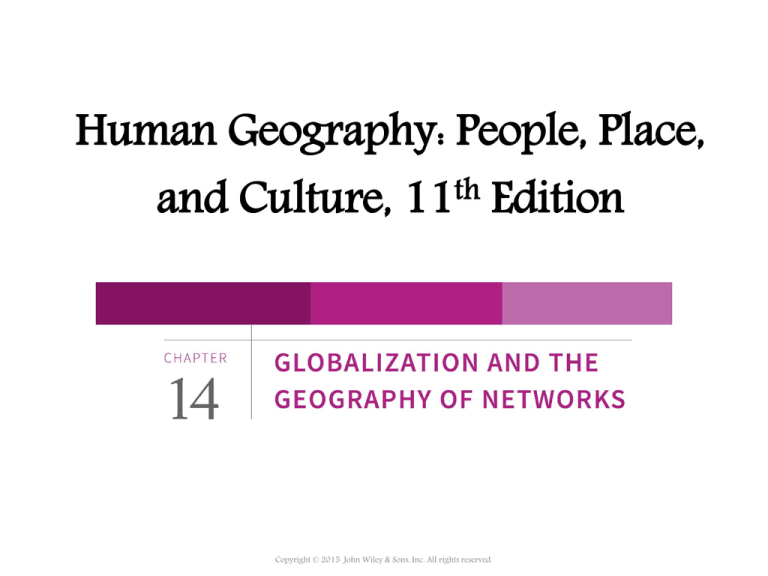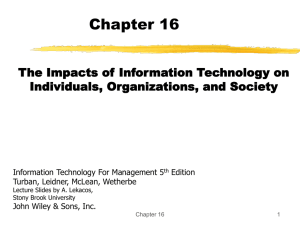
Human Geography: People, Place,
and Culture, 11th Edition
Copyright © 2015 John Wiley & Sons, Inc. All rights reserved.
Chapter 14: Globalization
and the Geography of Networks
Concept Caching:
Malacca, Malaysia
© Barbara Weightman
Copyright © 2015 John Wiley & Sons, Inc. All rights reserved.
•
•
Globalization is a “chaotic” set of processes and outcomes
created by people.
Globalization of : a) Identity b) Economy c) Culture
Key Question 1:
How Have Identities Changed in a Globalized World?
• Globalization networks link us with other people
and places, and the flow of information technology
is a daily way in which we are interlinked with the
globe.
• People identify themselves by identifying with or
against others at local, regional, and global scales.
• As the flow of information continues, many people
feel a need to make sense of the world by identifying
with people and places.
Copyright © 2015 John Wiley & Sons, Inc. All rights reserved.
Personal Connectedness
• The idea that people around the world are linked and have
shared experiences, such as death, tragedy, sorrow, and even
joy, draws from Benedict Anderson’s concept of the nation as
an imagined community.
• The desire to personalize, to localize, a tragedy or even a
joyous event feeds off of the imagined global community in
which we live.
• In the process of personalizing and localizing, events can be
globalized in an effort to appeal to the humanity of all people
with the hope that all will feel or experience the loss or joy
tangentially.
Copyright © 2015 John Wiley & Sons, Inc. All rights reserved.
• The underpinning of globalization is – globalization of
economic activities, a global division of labor.
• The backbone of economic globalization is: trade.
Copyright © 2015 John Wiley & Sons, Inc. All rights reserved.
The arguments in favor of globalization, as explained by
economist Keith Maskus:
• “Free trade raises the well-being of all countries by inducing
them to specialize their resources in those goods they
produce relatively most efficiently” in order to lower
production costs.
• “Competition through trade raises a country’s long-term
growth rate by expanding access to global technologies and
promoting innovation.”
• Washington Consensus: World Bank, the International
Monetary Fund, and the World Trade Organization.
• The globalizing trends of the last few decades mean that we
are, in many respects, living on an unprecedented scale.
• Manifestation of neocolonialism?
Copyright © 2015 John Wiley & Sons, Inc. All rights reserved.
Key Question 2:
What Role Do Networks Play in Globalization?
Networks
• Manuel Castells defines networks as “a set of
interconnected nodes” without a center.
• A nonhierarchical network is horizontally
structured, with power shared among all
participants and ideas flowing in all directions.
• There are deeply entrenched hierarchies in the
networks that knit together the contemporary world.
Copyright © 2015 John Wiley & Sons, Inc. All rights reserved.
Time-Space Compression
• Time–space compression means that certain places, such as
global cities (especially in the core), are more interconnected
than ever through communication and transportation
networks, even as other places, such as those in the
periphery, are farther removed than ever.
• A major divide in access to information technology—
sometimes called the Digital Divide—is both a hallmark of
the current world and an example of the uneven outcomes of
globalization.
• The quickening pace of technological change is another
hallmark of globalization and magnifies the global
technological divide.
Copyright © 2015 John Wiley & Sons, Inc. All rights reserved.
Time-Space Compression
Global Cities
• Time–space compression has helped to create and
reinforce a network of highly linked global cities.
• The linkages among global cities provide insights
into the spatial character of the networks that
underlie globalized processes.
• “Placelessness” in the cultural landscape!
Copyright © 2015 John Wiley & Sons, Inc. All rights reserved.
Copyright © 2015 John Wiley & Sons, Inc. All rights reserved.
Castells claims that the age of information technology is
more revolutionary than either the advent of the
printing press or the Industrial Revolution.
Do you agree with him? Write an argument in support
of your position, drawing on your understanding of
the role of changing geographical circumstances over
the past several hundred years.
Copyright © 2015 John Wiley & Sons, Inc. All rights reserved.
Key Question 3: How Do Networks Operate
in a Globalized World?
Networks with a Social Focus
• The term network defines any number of interlinkages
across the globe, whether transportation, educational,
financial, or social.
• Social networks, such as Facebook and Twitter are
credited with making revolutions in Tunisia and Egypt
possible.
Copyright © 2015 John Wiley & Sons, Inc. All rights reserved.
Networks with a Social Focus
Participatory Development
• Participatory development—the idea that locals
should decide what development means for them
and how to achieve it—is another response to topdown decision making.
• Nongovernmental organizations (NGOs) are
nonprofit institutions outside of formal governance
structures that are established to promote particular
social or humanitarian ends.
• Each NGO is a social network.
Copyright © 2015 John Wiley & Sons, Inc. All rights reserved.
Networks with a Social Focus
Participatory Development
• NGO development networks serve as a counterbalance to the
power of the major decision makers in the world
• The World Bank, the International Monetary Fund,
and state governments are increasingly embracing the
ideal of participatory development, loosening demands
for trade liberalization in the periphery and
semiperiphery.
Copyright © 2015 John Wiley & Sons, Inc. All rights reserved.
Networks and Information
• Through a series of mergers and consolidations occurring
mostly in the post–Cold War era, global media are controlled
largely by six globe-spanning corporations:
– Time-Warner
– Disney
– Bertelsmann
– Viacom
– News Corporation
– Vivendi Universal
Copyright © 2015 John Wiley & Sons, Inc. All rights reserved.
Networks and Information
• These six media corporations (along with other
media corporations) are corporations of vertical
integration: those that have ownership in all or most
of the points along the production and consumption
of a commodity chain.
• Miguel Mendes Pereira noted that media companies
compete for three things:
content, delivery, and consumers.
Copyright © 2015 John Wiley & Sons, Inc. All rights reserved.
Networks and Information
• Vertical integration also helps media giants attract
and maintain customers through synergy, or the
cross promotion of vertically integrated goods.
• Vertical integration of media changes the geography
of the flow of ideas around the globe by limiting the
ultimate number of gatekeepers, that is, people or
corporations with control over access to
information.
Copyright © 2015 John Wiley & Sons, Inc. All rights reserved.
Networks and Economic Exchange
• Unlike major media corporations that are vertically
integrated—with ownership of relevant suppliers and
producers—major retail corporations are typically
horizontally integrated.
• Horizontal integration means that when you shop for similar
products in different places or across a mall, your dollars
often support the same parent corporation.
Concept Caching:
Malacca, Malaysia
Copyright © 2015 John Wiley & Sons, Inc. All rights reserved.
© Barbara Weightman
Beneficiaries of Contemporary Globalization
Multinational Corporations (MNCs)
Foreign Direct Investment (FDI)
Q: MNCs clearly benefit from FDI; however, it is frequently at
the expense of local businesses.
Copyright © 2015 John Wiley & Sons, Inc. All rights reserved.
Q: Aside from the MNC’s,
who else benefits from FDI?
Copyright © 2015 John Wiley & Sons, Inc. All rights reserved.
Networks and Economic Exchange
Community-Supported Agriculture
• With the industrialization of agriculture, the distance
between farmers and consumers has increased, figuratively
and literally.
• According to geographer Steven Schnell, one of the reasons
the number of farmers in the United States has increased is
the growth in the number of community-supported
agriculture groups, known as CSAs.
• CSAs began in Japan in the 1960s when a group of women
“dissatisfied with imported, processed, and pesticide-laden
food, made arrangements directly with farmers to provide
natural, organic, local food for their tables.”
Copyright © 2015 John Wiley & Sons, Inc. All rights reserved.
Cultural Impacts of Globalization
Popular Cultural
“Placelessness”
“McDonaldization”
Americanization
Neolocalism
Glocalization
Copyright © 2015 John Wiley & Sons, Inc. All rights reserved.
The Commodification of Culture
Heritage Industry
Yoga
Acupuncture
UNESCO
World Heritage List
http://whc.unesco.org/en/lis
Q: Is there anything wrong with commodifying
these elements of culture? Why or why not?
Copyright © 2015 John Wiley & Sons, Inc. All rights reserved.
Additional Resources
• Media ownership: Columbia Journalism Review’s Who Owns
What Website ww.cjr.org/tools/owners/
• The Network of World Cities
http://www.brook.edu/metro/pubs/20050222_worldcities.pdf
• World Social Forum www.forumsocialmundial.org.br/
• Links on Geography Education
– Globalization, NGOs, Time-Space Compression, social
media.
Copyright © 2015 John Wiley & Sons, Inc. All rights reserved.




